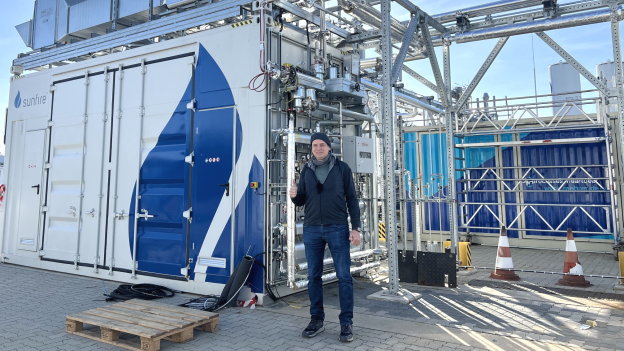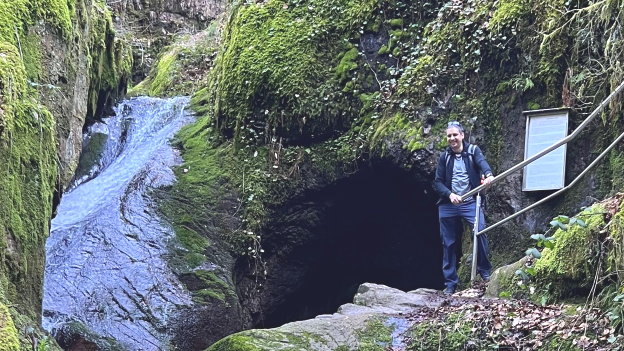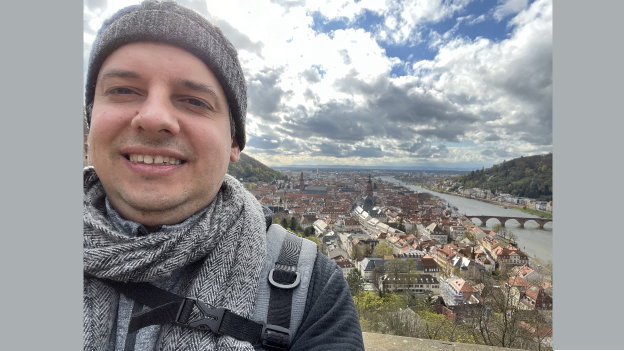Athanasios Tountas
 Privat
Privat
Athanasios Tountas infront of the Energy Lab KIT North
“The KSB Stiftung Scholarship and support provided by DAAD-Stiftung enabled my research visit to be enjoyable and memorable, allowing me to focus on important things like people and collaborations that made the visit worthwhile.”
The opportunity to come to Karlsruhe with a KSB Stiftung Scholarship not only broadened Athanasios Tountas' scientific horizons but also enriched him personally.
In interview form, he describes his professional achievements and his cultural experiences during his time abroad:
How did your research stay progress?
Our research collaboration mainly focuses on photochemistry for chemical synthesis such as methanol and dimethyl ether and the reverse photo reforming process producing hydrogen. If successful, this process will help enable the ‘hydrogen economy’. Our solar fuels group in Toronto has collaborated with Karlsruhe Institute of Technology - Institute for Micro Process Engineering (KIT IMVT) since 2016 on improving the efficiency and quantification of photoreactors and photocatalysts with the objective of increasing the technology readiness level. The premise of this visit was to appreciate and learn the best practices spearheaded here using aerogel photocatalyst support to extend them to the macroporous ceramic supports and photoreactors we use in Toronto. Working alongside other optochemical engineers has enabled me to iterate designs and validate approaches more quickly. This was a gradual outcome in which methodologies were compared and best approaches adopted. Collaboration will continue as we share and learn from each other and validate and extend different simulation techniques with actinometry experiments conducted at KIT. The success of this effort will be contingent on our continued progress at increasing the technology readiness level of our technology.
What was it like to work at the KIT?
Toured many of the advanced pilot-scale facilities at IMVT regarding micro fabrication, additive manufacturing, and energy lab for offshore wind energy to methanol and ammonia. Highlights were the scaled RWGS system as well as the process requirements of the micro reactor that we previously obtained from KIT that I sent ahead of arriving here. I learned what other photo catalyst researchers are doing here. One colleague is using a membrane photo reactor that had applications in photo degradation of water pollutants, but now she’s using it as a methanation photoreactor. Focus on the prospect of membrane reactors for low temperature synthesis for shifting the equilibrium the same way as we use low temperature photochemistry for the shift. Getting to KIT north campus from the Guesthouse was an enjoyable commute, first by bike then by bus. The commute allowed for appreciation of the spring season in Germany.

Privat
At the 1921 built ammonia reactor of the Haber-Bosch process
Which findings or achievements did you bring home for both yourself and your research?
We characterized our UV LEDs used in Toronto; a measurement we current cannot easily do. This consisted of a goniometer setup at the Light institute at the KIT south campus. We used the full strip of 60 elements to get an average power and dispersion as the sensitivity with the 365 nm wavelength was low. This can then feed into a more robust ray tracing simulation for which we can more accurately predict the photon flux to the outer glass surface which combined with the catalyst absorption characteristics can give us a quantum yield (emitted over absorbed) used for photoreactormefficiency quantification. As well as the LEDs wall plug power to photon efficiency. We prepared bare and photocatalyst loaded foams with two different ppi pores that were brought from Toronto so we can do a flow actinometry and activity testing. The first objective was to do the empty reactor tube as we want to know how many of the incident photons are absorbed from the longer LED array. We did three intensities to see if linear response so we can extrapolate to the high intensities we want for reactor testing. Upon returning will need to model the reactor configuration in more detail such that we have a comparison tool or validate the experiments with simulation. Also, our colleagues here will continue the experiments with the foams over the next days/ weeks. There are some issues to overcome when you introduce the foam as it will reflect a certain portion of the incident light while the rest will be absorbed by the actinometer, so knowing what proportion was reflected is key to correct the absorbed/incident light.
What are your next steps in you research project and your further academic career? We need to validate the experiments with simulation by providing a corrected amount of incident light. Once corrected it will likely change the open tube results by 10-20% so precision is important, especially between foam pore sizes. Our collaborator will try and see if we get a significant enough change within error tolerances while I will work on the simulations, as the simulations used here can’t introduce a foam or vary the length of the light source which is longer than the inner tube. We attempted to correct this by only exposing the foam portion of the reactor tube. I’ll discuss the limitations in more detail as the runs are carried out, as this is a new technique I’ve learned here used for direct validation for the modelling we've conducted so far. We have yet to analyze the results, but the idea is to find out wall plug power to absorbed photons with the same light source/light support structure we’re using in Toronto. We will leave our reactor materials here for further study i.e. see if we can quantify our photocatalyst support foams using actinometry.

Privat
Exploring the Black Forest
How did you, as a Canadian, experience everyday routine and the difference in both work related and personal ways of life in Germany?
Life in Karlsruhe was an eye-opening experience. Good bike sharing and transport infrastructure, centrally located Guesthouse and affordable quality of life all contributed to a feeling of connection to the place and everyday routines. On the first weekend we did a bike tour around the city and had to walk them most of the time due to the sheer number of people enjoying the city’s many restaurants, gardens and dessert establishments. Also, I enjoyed discovering the many varieties of pretzels and pastries Germany has to offer except once when running out of food on a Sunday. I was able to do many outdoor excursions within and outside the city with the local trains to nearby tourist sites such as Black Forest, Speyer, Heidelberg, Turmberg, and Switzerland with relatively little problems.
How far did your research at the KIT influence your academic path going forward?
Before this trip I did not consider living and working in Germany as an option. I will keep an eye out for opportunities in and around the country from now on and opportunities to visit again either as an academic or otherwise.

Privat
A wounderful view of Heidelburg captured by Athanasios Tountas
Have you managed to establish academic and/or personal contacts that will probably outlast the completion of your stay in Germany?
The colleagues I met were very helpful and willing to share their research and outlooks for the future of green energy and sustainable chemical synthesis. KIT has state-of-the-art facilities and technology integration that is a motivation for me moving forward. Maintaining the building on the relationships started here with undoubtably help both our labs and countries work closer together on shared challenges and opportunities.
Which cultural or personal experiences will you keep in memory the most?
The people I met and way of life in Germany are distinct and very memorable. Be it going to lunch together as group every day, the German cuisine, the many coffee breaks, after-work or weekend beers and discussions and openness of the colleagues to share their motivations and experiences. This trip for me was insightful into how Germany, a world leader in the field of sustainable energy, can work collectively towards the goal of net-zero carbon emissions by the end of the decade, and perhaps act as a template for the rest of the world.
As of April 2024.


